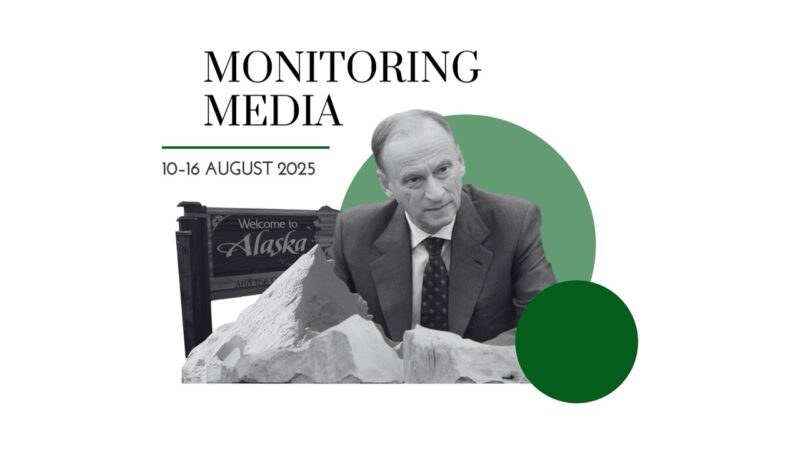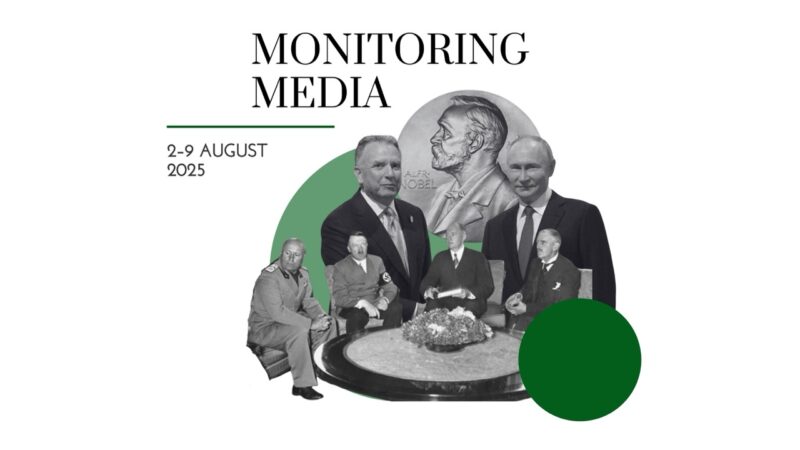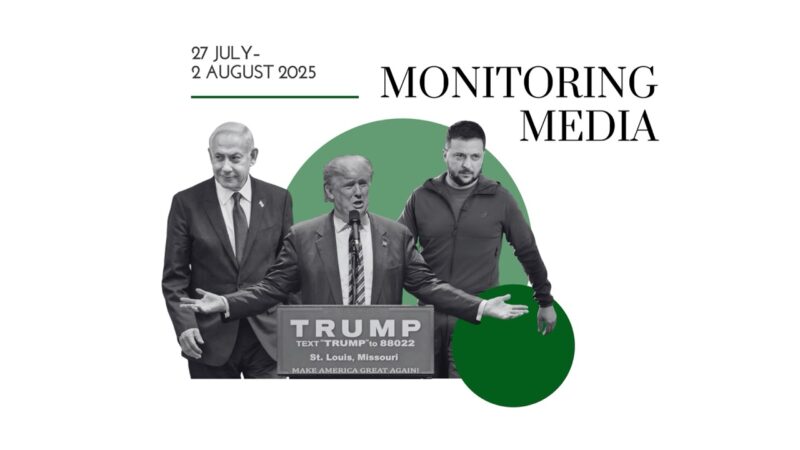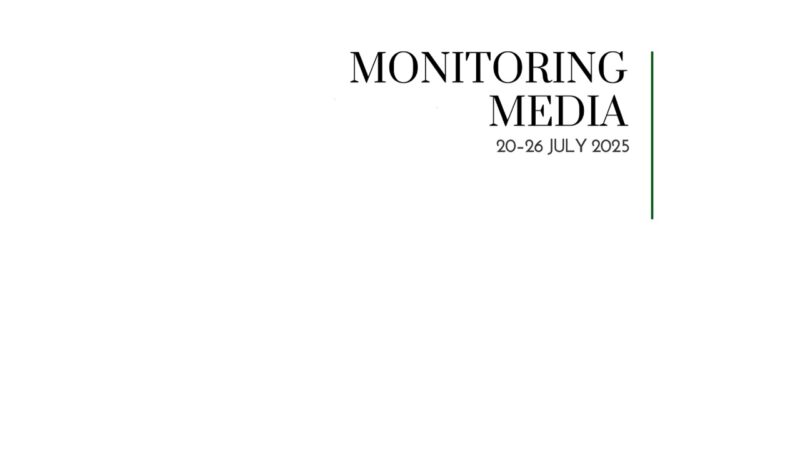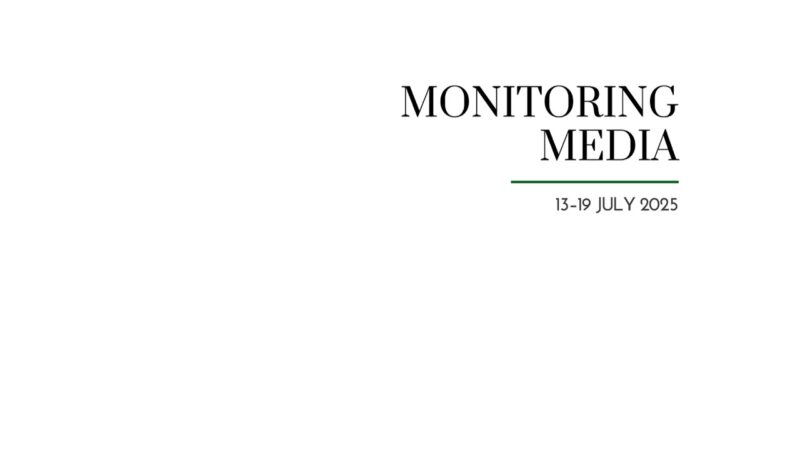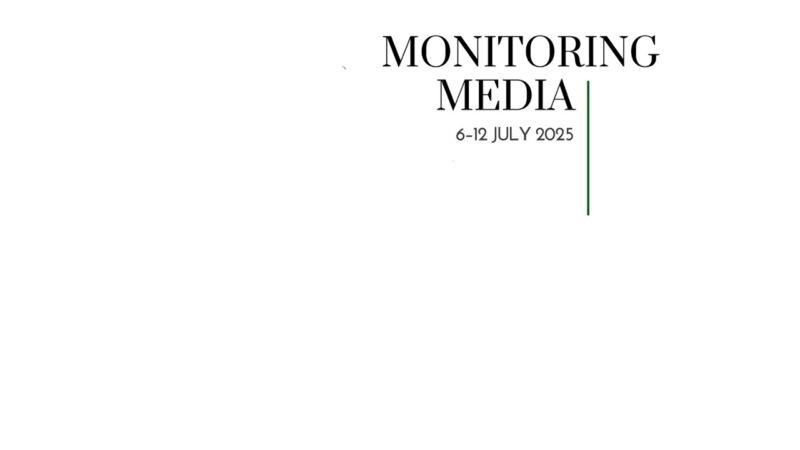A war of attrition in Europe that may redesign the world order

CIUS weekly report on media coverage of Ukrainian affairs, 02–08 May 2022
Four North American online magazines (Foreign Affairs, The Wall Street Journal, National Review and The Conversation) were selected to prepare a report on how the situation in Ukraine has been portrayed in the media during the past week (02–08 May 2022). The sample of magazines was created based on their impact on public opinion, as well as their professional reputation, popularity among the readership, and topical relevance. Overall, the four magazines represent the centrist, liberal, and conservative political spectrum.
This report covers only the most-read articles about Ukraine in the past week, as ranked by the respective magazines themselves. It also covers promoted texts on home pages; texts from special sections on Ukraine; texts from paper versions of the magazines; and texts about Ukraine from opinion columns and editorials.
Topics featured in the selected articles
- Ukraine at war: social belief in imminent victory, construction of national identity, cyber-volunteers’ military might, the economics of post-war reconstruction
- Russia at war: Putin’s fears and obsessions with Ukraine, reasons behind the poor performance of the Russian army, the importance of Victory Day 2022
- the world and the war: erosion of global post-Cold War order, the evolution of the global economic crisis, US stakes in the war, challenges to foreign policies of Asian states.
The most common arguments
Ukrainians believe they will win the war. Daniel Twining (Wall Street Journal) discusses the findings of a nationwide poll conducted in Ukraine by the International Republican Institute. He points out three specific results: Zelensky commands a 94% approval rating; 80% of Ukrainians aspire to join the EU and 59% NATO; and 97% of Ukrainians believe they will win the war. Twining concludes that the invasion of Ukraine has achieved “the opposite of everything Vladimir Putin intended” and that the resolve of Ukrainians will have strong implications for how the war ends.
Ukraine is holding its ground not least thanks to Western military aid. Jordan Cohen (The Conversation) specifies four main categories of weapons that the West has already sent Ukraine: “basic guns and ammunition, missiles, attack drones and artillery.” The lion’s share of these supplies consists of firearms that are easily shipped between states, can be quickly mastered by Ukrainians, and are essential for defence operations. Cohen concludes that regardless of the numerical advantage of the invading forces, “international military support for Ukraine is preventing Russia from holding land and establishing air superiority.”
War in Ukraine is also being waged over national identity. Georgiy Kasianov (Foreign Affairs) argues that the Kremlin’s historical misconceptions and delusions played a crucial role in igniting the war: “Putin’s desire to restore an imperial Russia (of which Ukraine is [merely] a constituent part) has crashed into a Ukrainian nationalism that imagines a sovereign Ukrainian state and a distinct Ukrainian people persisting in various forms for over a thousand years.” Kasianov argues that Russia ignores or downplays any events in Ukraine’s history if they contradict Russian narratives. This makes the war existential for Ukrainians, because Putin’s reading of history denies their right to exist.
Ukraine has recruited a global army of cyber-volunteers. Elizabeth Braw (Foreign Affairs) highlights that over 400,000 specialists from all across the world responded to Kyiv’s invitation and joined the “IT Army of Ukraine.” Their successes have been impressive: from hacking Russian state television and broadcasting Ukrainian content there to allegedly compromising Russian control over its spy satellites. This said, Braw warns of the dangers of a volunteer army: it lacks a command-and-control system and does not abide by the laws of war. In other words, the IT volunteers may attack the wrong targets, do so with excessive brutality, and try to avoid responsibility.
Ukrainian refugees are boosting the economies of host states. Dany Bahar (Foreign Affairs) encourages regarding Ukrainian refugees in Poland and elsewhere as people who “can create new economic activity that more than offsets the immediate expenses.” Bahar refers to a 2016 study by the McKinsey Global Institute: “although migrants [including refugees] represent only 3.4 percent of the global population, they create nearly 10 percent of global GDP.” The latter figure is over “twice the size of what they would have produced if they never moved.” However, to obtain the economic boost, host states should provide the refugees with freedom of movement, full access to labour markets, and long-lasting legal residency.
The war in Ukraine provides a chance for the West to modernize economically. Mikhail Khodorkovsky (Wall Street Journal) argues that Putin perceives the Russian war in Ukraine as a collision with the broader West. Therefore, the West should not backtrack but adopt a three-pronged course of action: “Eliminating its hydrocarbon dependency [on Russia], helping Ukraine to victory and revival [with modernized industries], and planning for a de-Putinized Russia.” Khodorkovsky specifically highlights that “democracies will never achieve long-term economic stability if they are susceptible to energy blackmail from dictatorships” and that “Ukraine is the impetus to accelerate the [world’s] move away from fossil fuels.”
Russia’s foreign policy reflects Putin’s alarm over the “colour revolutions.” Writing about the Georgian (2003), Ukrainian (2004 and 2014), and recently Belarus (2020) and Kazakh (2021) anti-governmental protests, Lincoln Mitchell (Foreign Affairs) argues that “the continual fear of anti-regime pressure from below has given those events a central place in the Kremlin’s anti-democratic and anti-Western ideology.” To prevent the strengthening of the West in post-Communist space and mitigate the spillover of democracy into Russia as well as solidify its domestic hierarchy of governance, the Kremlin went on the offensive in the region. It resorted to cyberwarfare, disinformation campaigns, nurturing of separatist movements, and amassing troops on the borders. Eventually, the Kremlin launched an escalated full-scale invasion of Ukraine.
Russia’s conscripted troops cannot conquer Ukraine. Max Z. Margulies and Laura Resnick Samotin (Wall Street Journal) argue that today, when an army of volunteering soldiers fights an army of involuntary conscripts, the former will prevail. This is not only a matter of high morale but also the quality of training, battlefield companionship, and speed of pulling up reserves. Russia’s failing invasion of Ukraine provides an appropriate example. Moreover, injured Russian conscripts on their return home may trigger an economic downturn and foment anti-government attitudes. The Russo-Ukrainian war demonstrates the limits of a conscripted army to other states who massively rely on it.
Russia’s high-tech weaponry is largely made of Western parts. Daniel Salisbury (The Conversation) highlights that post-Soviet Russia built on the USSR’s experience of illicitly acquiring Western technologies. Many such components found their way into Russian weaponry from civilian equipment that was designed for dual-use. There also exists evidence that Russia violated licence conditions and overstepped the consent of state-manufacturers to access their technologies. Salisbury enjoins Western governments to introduce more rigorous control over their arms exports and remove corrupt intermediaries.
Russia’s Victory Day is a celebration of state might and leadership for domestic consumption only. Miriam J Dobson (The Conversation) notes that Soviet celebrations of the Nazis’ surrender in WWII became most pompous in times when personality cults were at their heights. Above all that was the case with Joseph Stalin and, later, Leonid Brezhnev. The role of veterans had always been instrumental; their survival and war stories served as evidence of the genius of Bolshevik leadership. As for today, in the Putin era, “the year 1945 can be commemorated as the moment when Moscow’s global reach was at its greatest, while the veterans…can be celebrated for their patriotic self-sacrifice and discipline.”
For more information on the Soviet instrumental and inhuman treatment of WWII veterans, consider watching a short video by TeleconStudio.
Russia may formally declare war on Ukraine on Victory Day. Michael A. Allen (The Conversation) warns that if Putin uses the term “war” instead of “special operation” in his 9 May speech, this will introduce a major change in Russian domestic policy: the population will be mobilised to wage a long conflict that requires their readiness for conscription and acceptance of financial austerity. Despite the fact that it was Russia committing the first act of aggression in February 2014, all this time the Kremlin avoided defining its conflict with Ukraine as a “war” in order to avoid international condemnation, economic deterioration, and domestic fatigue.
Russia uses Cold War rhetoric for its nuclear blackmail. Michael Mulvihill (The Conversation) points out that Russia tested its newest Sarmat intercontinental ballistic missile on 29 April 2022. The missile is allegedly capable of carrying explosive payloads for up to 18,000 kilometres. In his speech Putin stated that the missile has no analogues and should become “food for thought for those who […] try to threaten our country.” This statement, alongside many others that Putin delivered in recent years, alludes to the Mutually Assured Destruction (MAD) doctrine from the 1960s and the deterrence that followed afterwards.
The West has revived the Cold War concept of the “Free World.” Decades ago, the “Free World” stood for the democratic West with its universal values and excluded such states as India or Pakistan. It was also tailored to curtail authoritarianism, a plague that is eroding and fracturing the West today. Peter Slezkine (Foreign Affairs) considers the revival of the “Free World” to be a counterproductive move, as it will “produce a familiar set of problems: an insistence on viewing distant wars as decisive tests, an intolerance of nonalignment, an inability to formulate a common purpose in positive terms, and a reliance on the enduring evil of the enemy.” Slezkine calls for inventing a more flexible policy approach.
The war in Ukraine has unveiled threats to the current world order. Michael J. Mazarr (Foreign Affairs) writes that the “post-1945 U.S.-led international order is by far the most institutionalized rules-based order to date.” Its legitimacy and functionality derive from the economic alignment of less powerful states with more powerful ones that are also democratic. In other words, the “critical mass of the world community” agrees to build its prosperity and security in a liberal and democracy-based environment. Therefore, it is not the Russian invasion of Ukraine that constitutes a vital threat to the current order—rather, it’s the reaction of the US and its allies, with their uncritical desire to enlarge Trans-Atlantic structures, interventions to enforce the rule of law, and exerting pressure on middle powers. Mazarr concludes that the current world order may perish “with a whimper, as middle powers gradually drift away from its core institutions, decline to enforce its norms, and join China and even Russia in various efforts to formulate a more multipolar world system.”
Russia is dismantling the peace-securing mechanisms of the current democratic world order. Leif Wenar (Wall Street Journal) declares that Russia violated the UN Charter by forcefully appropriating the territory of another UN member. This practice had been common before 1945 and triggered numerous wars, including WWII. If Russia is successful yet again in its territorial grabs and the world accepts their legitimacy, then China and a few other states may follow the precedent. The stability of the global order would then deteriorate even more rapidly.
The West should prevent a Syrian-type catastrophe in Ukraine. Nicolas Tenzer (The Conversation) argues that Russia promulgated a new type of war in Syria—a war of extermination—and has exported it to Ukraine. At the same time, the Western response remains comparatively weak and inertial. The international support provided to Ukraine neither allows a successful defence of its borders nor efficiently brings the aggressor to justice, at least today. Tenzer concludes: “We must now apply the Syrian lesson to Ukraine. Any retreat, accommodation, or appeasement with Putin’s regime will result in greater crimes on the ground.”
If not stopped, the war in Ukraine will lead to a global crisis. Olga Oleinikova (The Conversation) highlights that the Russian invasion is already triggering “economic disruption and increasing poverty, food insecurity, and inflation” far beyond the region. Moreover, an unprecedented humanitarian crisis has developed in Europe, forcing millions of Ukrainians to suffer from a deficit of food and medicines, or simply to flee. Oleinikova encourages the world’s NGOs, financial institutions, and governments to curb the spread of the crisis.
The US should be proactive in Ukraine, as democracy itself is at grave risk. Andriy Yermak (National Review) argues that the US has a stake in Ukraine’s victory: “If Mariupol falls, if Ukraine loses, it will not only be a loss for Ukrainians. All the world’s democracies will lose. Despotism will triumph.” Yermak compares Mariupol today with the Alamo of 1836, where the besieged Texans fought against an army ten times larger. The heroes of Mariupol should “survive and prevail” to show that democracy stands strong against dictatorship. For this, Ukraine only needs more weapons, as it already has the indispensable fighting spirit.
The US needs to recalibrate its foreign policy in light of the Russo-Ukrainian war. Matthew Duss (Foreign Affairs) writes that Washington’s commitment to Ukraine is as strong and resolute as anything since 9/11. This time, however, the US should not pursue binary “us versus them” policies but rather opt for making Ukraine the leader in its own fight: “The United States and its allies should continue to supply defensive weapons, but [not] threaten Russia more directly—for example, by signalling preparations to ‘win’ a nuclear war.” Also, Duss argues that “Washington should strengthen sanctions that target regime officials with decision-making power and deny access to materials and technology necessary for Russia’s war effort.” At the same time, the US should provide support and encouragement to developing states that face economic repercussions due to the war.
The US and NATO’s strategic objective is a weakened Russian army. Frank Ledwidge (The Conversation) argues that the US and NATO, with the help of Ukrainians, are aiming to exhaust the Russian army so much that it will not be able to threaten anyone for decades. This strategy carries some risks, such as a possible split in the NATO camp or Russian nuclear retaliation. Therefore, Ledwidge suggests the solution of inflicting as much damage as needed to get the Kremlin to the negotiation table. This may be achieved by consistent rearmament of Ukraine, continuous destruction of invading troops in the Donbas, and executing a successful counter-attack in summer. Ledwidge underscores that “the initiative is now with Ukraine’s defenders.”
US volunteers are engaged in dealing with the humanitarian crisis. Ryan Mills (National Review) writes of the Project Dynamo functioning in Ukraine: “Over the last two months, the donor-funded nonprofit has completed more than 45 rescue missions and extracted more than 550 people from the country.” Many of these missions were coordinated from North America, which triggered additional challenges for the volunteers due to the time zone differences. This said, the volunteers state that they have always found their work rewarding.
China is supporting neither the West nor Russia in this war. Yan Xuetong (Foreign Affairs) claims that the government in Beijing faces a strategic conundrum. Taking a pro-Western stance in the war would antagonize the Kremlin and harm bilateral trade. Meanwhile, adopting a pro-Russian position would prompt Washington to strengthen its containment policies against China and simultaneously antagonize smaller states in the neighbourhood. Xuetong concludes that “China will likely hew to this middle path until the war in Ukraine is over” unless “the United States provides military support for a Taiwanese declaration of de jure independence.”
Vietnamese social media spread pro-Russian disinformation. Quoc Tan Trung Nguyen (The Conversation) reports that Vietnamese TikTok and Facebook influencers blamed Ukrainian media for distorting their national history as well as popularizing prejudices toward Vietnam. Furthermore, the influencers “accused the Ukrainian government of being a neo-Nazi institution, mocked Ukraine’s ‘comedian’ president, and suggested that Ukraine deserves to be annihilated for betraying Lenin.” For its part, the government of Vietnam tries to balance between Russia, Ukraine, and the West. It did not condemn the Russian invasion of Ukraine during the UN vote in March 2020, yet it is lobbying for international support to be elected to the UN Human Rights Council.
Worth your attention
The Russian invasion of Ukraine is a regional conflict and should be dealt with appropriately. Peter Slezkine (Foreign Affairs) speaks against the global mobilization against Russia under the “Free World” banner: “It is not too late to devise a flexible and regionally attuned foreign policy that does not require a worldwide mobilization against a single, globally interconnected existential threat. Attempting to lead something called the free world is not a grand strategy. It’s a trap.”
The political actor into which Russia has evolved under Putin is exactly the “single, globally interconnected existential threat” that launched the biggest war in Europe under false premises, deployed heavy weaponry against civilians, exploits its own population for military purposes, has committed atrocities and war crimes, continues raising the stakes in its negotiations with the West, and threatens other sovereign nations. Such behaviour has never been observed on the European continent since the end of WWII, especially with respect to NATO members such as Poland or the Baltic states.
The “flexible and regional attuned foreign policy” will likely not suffice to stop the war, as indeed it was not enough to prevent it under the framework of either the Minsk Agreements or the Normandy Format.
Coordinating global “Free World” policies, as well as defining who are the members of the “Free World” in the first place, is a challenging task. It is no less challenging to select an undisputed leader of the “Free World.” However, this seems to be a necessary task today. Many European states, even such cautious actors as Germany or France, seem to have embraced it. Governments in Berlin and Paris are actively redesigning their policies toward Russia, which they had been developing for decades.
The “Free World” grand strategy requires much effort, but curtailing Russian aggression seems to have become the vital interest of the majority if not all of the democratic states in the world.
Western policies today pose a threat to the Western-designed world order. Michael J. Mazarr (Foreign Affairs) writes that “the architects of the postwar system risk pushing their objectives too far and generating a violent backlash. This is arguably what happened with NATO in Europe. Under the United States’ watch, the alliance metastasized from a measured and carefully calibrated program to fortify European security into a limitless, duty-bound imperative. Without endorsing the legitimacy of Russia’s claim to dominate the countries of its near abroad, it is possible to acknowledge that Moscow was always bound to object to NATO’s expansion into areas it perceives as core security concerns.”
Mazarr puts forward two problematic claims. The first is that NATO is expanding into the post-Communist space. The second is that Russia started the invasion of Ukraine as a reaction to the alleged NATO expansion.
The Russia-promoted term “expansion” with respect to NATO is certainly misleading. In this light, analysts have challenged the agency of NATO members. It appears (so they claim) as if it was not sovereign states that formed the Alliance for their protection but rather that the Alliance purposefully “expanded” to incorporate sovereign states. Thus, it is advised to use the term “enlargement” with respect to NATO, which also reflects the Alliance’s own wording. For better insight, we suggest reading this article by Daniel Ramallo (The National Interest).
The idea of NATO’s enlargement as the casus belli for Russia has many weak points. To begin with, the Alliance is a defensive, not an offensive organization. It has never aimed to threaten Russia; quite the opposite, Russia developed a unique institutional framework of cooperation with it. NATO exists to provide security to territorially small European states that have always recognised Russian military prowess. For more details, consider reading this article by Hans Petter Midttun (Euromaidan Press).
Articles by Leif Wenar (Wall Street Journal) and Nicolas Tenzer (The Conversation) also challenge many of Mazarr’s arguments.
